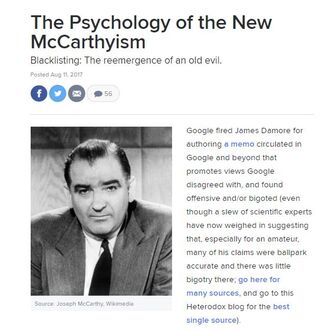Ethics and Morality
Are We Eroding Academic Freedom?
Commentary: Suppressing expression of controversial ideas.
Posted November 11, 2021 Reviewed by Lybi Ma
Key points
- Academic freedom is threatened more by censorious social norms than by government censorship.
- Many university administrators make soaring proclamations of support for academic freedom.
- When faced with threats to their agendas or unhappy constituents, administrators may abandon their proclaimed value for academic freedom.
In previous posts (here and here), I argued that social and organizational norms often constitute a far more severe threat to free speech, academic freedom, and open inquiry than does government censorship. In this post, I present the recipe by which colleges and universities, intentionally or unintentionally, suppress free and independent expression of controversial ideas.

First, create camouflage. Make it hard for people to discover your attacks on academic freedom when you are ready to unleash them.
How do you create camouflage? Make soaring public affirmations of how much you and your institution value academic freedom.
Great, the camouflage is in place. Now, the playbook:
1. Create rules, policies, and internal organizational bureaucracies and practices that are committed to all sorts of things except academic freedom and free expression. Such bureaucracies may have all sorts of laudable purposes, such as improving alumni relations, raising endowment dollars, preventing harassment, or advancing diversity, equity, and inclusion. However, bureaucrats whose expertise is anything but academic freedom, and whose explicit missions are elsewhere, are not only unlikely to protect it when threatened, but they are also likely to trample it while pursuing their missions.
2. Enable, embrace, or, at minimum, appease mobs calling for people’s heads.
3. Make sure the mob understands what types of accusations it needs to level. It cannot be “this person said something offensive.” It has to be along the lines of accusing someone of
- Causing “harm.”
- Engaging in harassment of people from protected categories, marginalized groups, “minoritized identities,” and so forth.
- Engaging in some violation of professional ethics or standards.

4. Launch an investigation. Now that you have the right types of accusations in place, you must investigate them. “Harassment” charges are especially useful because policies are usually in place requiring investigations into all charges of harassment.
5. If you can fire the target, great! Mission accomplished! You have successfully punished someone for expressing an idea.
6. Even if you fail at getting the target fired, if you harass them with enough social media mobs, denunciations, and investigations, you may drive them to resign.
7. Even if they do not resign, you send a terrific warning to anyone else who would dare argue similar points to those of the Denounced, Mobbed, and Investigated. That message is “Keep your mouth shut, because this can happen to you, and you may not be so fortunate.”
8. Then repeat the camouflage. Something like this works well: “We place the highest value on academic freedom. However, it is not the only value we embrace. We embrace strong community and alumni relations, and we are working very hard to advance diversity, equity, and inclusion. Harassment and unprofessional behavior of any kind will not be tolerated.” I note here that I actually agree with those sorts of statements. However, when high-minded principles are deployed to justify sanctioning someone for expressing ideas that merely offend some people, but that do not constitute harassment of any actual person, the problem is the duplicitous application of those principles, not the principles themselves.

To be sure, harassment and unprofessional behavior are real issues and it is surely appropriate to put a system of sanctions in place for people who commit them. Of course, it is also necessary to put in a system of due process–like protections to ensure a high level of accuracy in distinguishing the unjustly accused from the justly accused, and, when in doubt, to err on the side of innocence. These sorts of protections, however, also seem to have eroded at some, perhaps many, universities, such as here and here.
Just as surely, neither alumni relations nor diversity, equity, and inclusion are inherently antithetical to academic freedom if instituted with sufficient care and concern about protecting it. However, with rare exceptions, I do not see a lot of universities rushing to institute policies or internal organizations tasked with protecting academic freedom. And when the institutional power and weight of some large organizational bureaucracy are organized around advancing some other goal, silencing someone can be the effect. In the absence of some sort of countervailing powers to protect academic freedom, the fire of free and open inquiry and discourse is likely to be extinguished.


